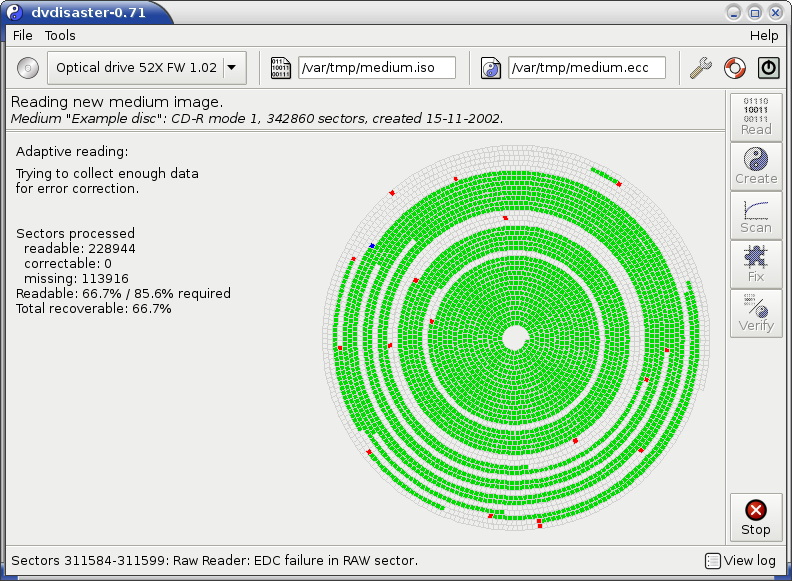The adaptive reading strategy
dvdisaster contains two different reading strategies.The adaptive reading strategy is recommended for:
- extracting data from damaged media
- creating images from undamaged media, e.g. to generate the error correction file
- scanning the medium for reading speed and read errors
Properties of the adaptive reading strategy.
The adaptive reading strategy uses a "divide and conquer" approach for locating still readable portions of a damaged medium. The strategy is based upon an article published by Harald Bögeholz in c't-Magazin 16/2005 where it was published together with the program h2cdimage:
-
At the beginning the medium is considered as a single unread interval. Reading begins
with sector zero.
-
The reading process continues sequentially unless either the end of the current interval
or a read error is encountered.
-
The reading process is terminated if either (3a) sufficient sectors for a successful
error correction have been read or (3b) no unreadable intervals exceeding a given size
remain.
- Otherwise the largest remaining unread interval will be determined. Reading continues in the middle (e.g. second half) of this interval; the first half of this interval is kept for a later reading pass.
|
The termination criterium (3a) is especially efficient: Reading will stop as soon
as enough sectors have been collected for a successful image recovery using the
error correction file. This can reduce the reading time by as much as 90 percent
compared with a full read attempt, but does of course only work when
an error correction file is available.
|

|
| Screen shot: Adaptive reading in progress |
Configuration
Error correction file. Adaptive reading works best when error correction data is available. Obviously the error correction data must have been created at a time where the medium was still fully readable. To use a error correction file during adaptive reading, enter its name before starting the reading process.
Limiting the adaptive reading range. Reading can be limited to a part of the medium. This is not recommended when error correction data is used since the limit might prevent sectors from being read which are required for a succesful error correction. If no error correction data is available, limiting the reading range might be helpful during multiple reading attempts.
Early reading termination. If no error correction data is available, adaptive reading will stop when no unread intervals larger than a selectable size remain.
The termination value should not be smaller than 128. Otherwise the laser head will have to carry out lots of repositioning moves during the final phase of the reading process. This will negatively affect both the life expectancy of the drive and its reading capability. A better approach is to stop adaptive reading earlier and then try reading the remaining sectors with an additional linear reading pass.